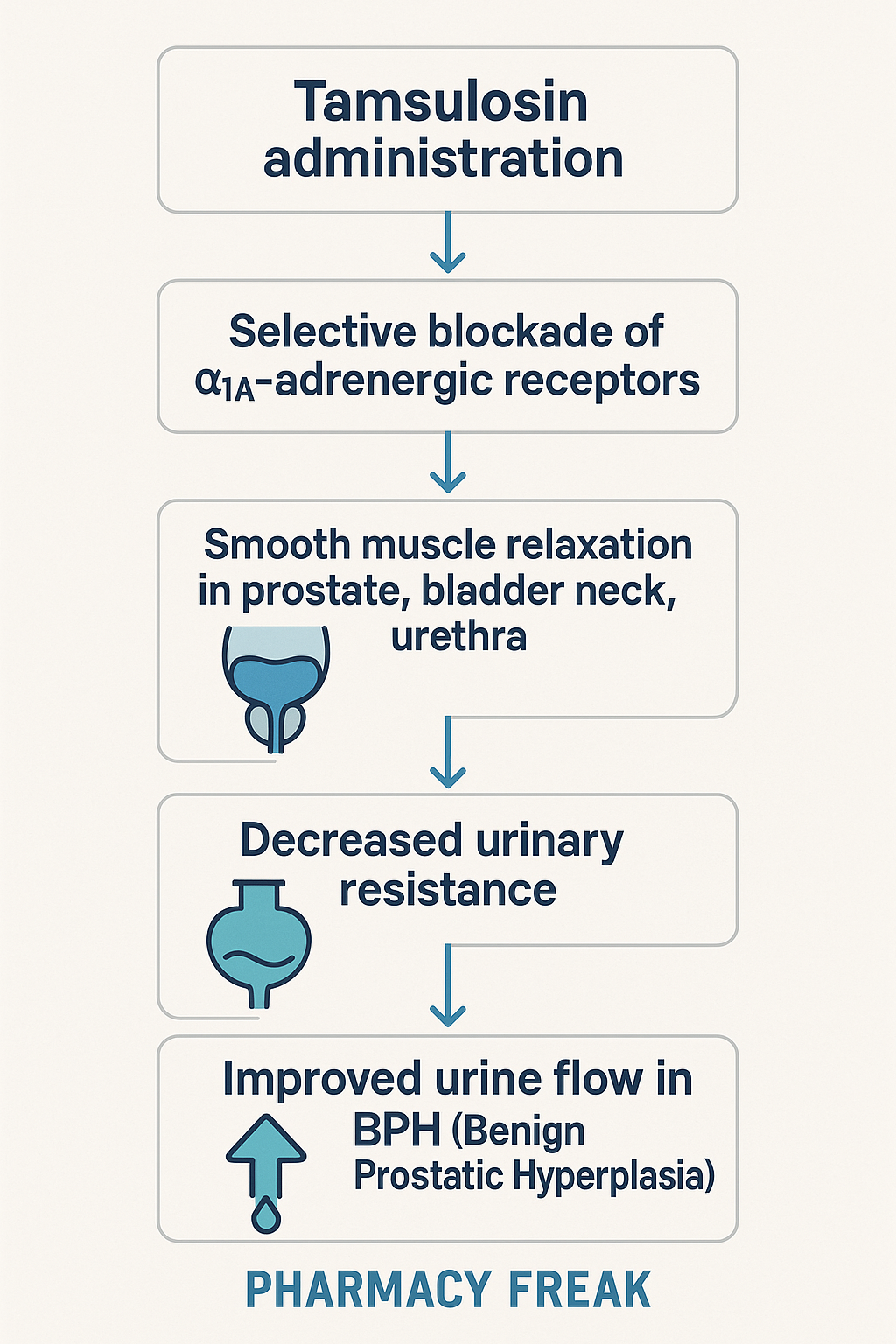Table of Contents
Introduction
Tamsulosin is a selective α₁A-adrenergic receptor antagonist, widely prescribed for the treatment of benign prostatic hyperplasia (BPH). By relaxing smooth muscle in the prostate and bladder neck, it improves urinary flow and decreases symptoms of lower urinary tract obstruction. Its receptor selectivity minimizes blood pressure effects compared to non-selective alpha blockers.
Step-by-Step Mechanism of Action
- Selective blockade of α₁A-adrenergic receptors
Tamsulosin preferentially antagonizes α₁A receptors located in the prostatic stroma, prostatic capsule, and bladder neck, reducing smooth muscle tone. - Reduction of intracellular calcium signaling
Receptor blockade limits G_q-mediated activation of phospholipase C, reducing IP₃ and DAG production, lowering calcium release from the sarcoplasmic reticulum, and causing smooth muscle relaxation. - Improved urinary outflow
Relaxation of muscle fibers at the bladder outlet and prostate decreases urethral resistance, facilitating urine passage and reducing hesitancy and incomplete emptying. - Minimal effect on vascular α₁B receptors
Low affinity for α₁B receptors in vascular smooth muscle results in fewer systemic hypotensive effects, providing symptom relief without significant blood pressure changes.

Pharmacokinetic Parameters
| Parameter | Value |
|---|---|
| Bioavailability | ~70–90% (oral capsule, empty stomach) |
| Time to Peak Plasma | 4–5 hours |
| Protein Binding | ~99% |
| Metabolism | Hepatic (CYP3A4 and CYP2D6 pathways) |
| Elimination Half-life | ~9–13 hours |
| Excretion | Renal (~30%), fecal (~70%) |
Clinical Uses
- Symptomatic management of BPH
- Off-label: urinary retention relief in bladder outlet obstruction
- Sometimes used adjunctively post-urethral surgery to ease urinary flow
Adverse Effects
- Orthostatic hypotension, dizziness (especially at treatment initiation)
- Ejaculation disorders (e.g., decreased volume, retrograde ejaculation)
- Nasal congestion
- Headache
- Rare: priapism
Comparative Analysis
| Alpha Blocker | α₁ Selectivity | BP Effect | Ejaculatory Side Effect |
|---|---|---|---|
| Tamsulosin | α₁A > α₁B | Minimal | Moderate |
| Terazosin/Doxazosin | Non-selective | Moderate | Lesser |
| Silodosin | High α₁A selectivity | Minimal | High |
MCQs (15 Questions)
1. Tamsulosin primarily blocks which receptor?
a) β₁-adrenergic
b) α₁A-adrenergic
c) α₂-adrenergic
d) Muscarinic M3
Answer: b) α₁A-adrenergic
2. The functional result of tamsulosin on prostate smooth muscle is:
a) Increased contractility
b) Relaxation
c) Necrosis
d) Hyperplasia
Answer: b) Relaxation
3. Which second messenger pathway is inhibited by tamsulosin?
a) cAMP
b) cGMP
c) IP₃/DAG
d) Calcium-induced calmodulin
Answer: c) IP₃/DAG
4. Why does tamsulosin have minimal blood pressure effect?
a) Low oral absorption
b) Selective for α₁B receptors
c) Poor α₁B receptor blockade
d) Rapid clearance
Answer: c) Poor α₁B receptor blockade
5. A common side effect related to ejaculation is:
a) Hypogonadism
b) Retrograde ejaculation
c) Premature ejaculation
d) Anorgasmia
Answer: b) Retrograde ejaculation
6. Tamsulosin is mainly metabolized by:
a) CYP2C9
b) CYP3A4 and CYP2D6
c) CYP2E1
d) CYP1A2
Answer: b) CYP3A4 and CYP2D6
7. Which parameter is approximately 9–13 hours for tamsulosin?
a) Time to onset
b) Elimination half-life
c) Bioavailability
d) Protein binding percentage
Answer: b) Elimination half-life
8. A drug with a similar indication but higher BP effects is:
a) Terazosin
b) Finasteride
c) Sildenafil
d) Tadalafil
Answer: a) Terazosin
9. Tamsulosin enhances urinary flow by:
a) Decreasing urine production
b) Increasing detrusor strength
c) Reducing urethral resistance
d) Shrinking prostate tissue
Answer: c) Reducing urethral resistance
10. Tamsulosin’s action on which organ results in ejaculatory side effects?
a) Testes
b) Prostatic urethra
c) Seminal vesicles
d) Bladder neck
Answer: d) Bladder neck
11. Tamsulosin requires caution when co-administered with:
a) PDE5 inhibitors
b) Loop diuretics
c) ACE inhibitors
d) Statins
Answer: a) PDE5 inhibitors
12. Maximum effect on urinary symptoms is achieved in:
a) 2–3 hours
b) 4–6 weeks
c) 24 hours
d) 6 months
Answer: b) 4–6 weeks
13. Absorption is best when taken:
a) With high-fat meals
b) On an empty stomach
c) With antacids
d) With grapefruit juice
Answer: b) On an empty stomach
14. Tamsulosin is classified as:
a) 5-HT₃ antagonist
b) α₁-adrenergic blocker
c) β₂-agonist
d) ACE inhibitor
Answer: b) α₁-adrenergic blocker
15. The indication for tamsulosin does NOT include:
a) BPH
b) Kidney stones
c) Bladder outlet obstruction
d) Ureteral stent discomfort
Answer: b) Kidney stones
FAQs
1. Does tamsulosin affect blood pressure?
It can cause dizziness but usually causes minimal systemic hypotension due to α₁A selectivity.
2. Can it be used safely in elderly BPH patients?
Yes, with cautions regarding possible lightheadedness upon standing.
3. Should it be taken with meals?
Best taken on an empty stomach to ensure optimal absorption.
4. Does tamsulosin shrink the prostate?
No—it only relaxes smooth muscle and does not affect prostate size.
5. When is ejaculation affected?
Approximately 10–20% of users may experience reduced ejaculation volume or retrograde ejaculation.
References
- Goodman & Gilman’s The Pharmacological Basis of Therapeutics, 13th Edition
- KD Tripathi. Essentials of Medical Pharmacology, 8th Edition
- StatPearls: Alpha Blockers in BPH Management
- PubMed: Efficacy and pharmacokinetics of tamsulosin
- Frontiers in Urology: α₁A Selectivity and urinary symptom improvement
- StatPearls: Tamsulosin dosage and side effects

I am pursuing MBA in pharmaceutical management from NIPER Hyderabad with a strong academic record and proven success in national-level pharmacy entrance exams. I secured AIR 61 in NIPER 2024 (MS/M.Pharm) and AIR 27 in NIPER MBA, along with AIR 147 in GPAT 2024 and AIR 907 in GPAT 2023. I also achieved AIR 6 in AIIMS CRE-2025 for Drug Store Keeper and was selected as a Pharmacist (AIR 61) for ESIC. Additionally, I was the Runner-Up in Round 2 of the EY Case Study Competition.
At PharmacyFreak.com, I aim to guide future pharmacists through expert content, exam strategies, and insightful resources based on real experience and academic excellence.
Mail- harsh@pharmacyfreak.com
